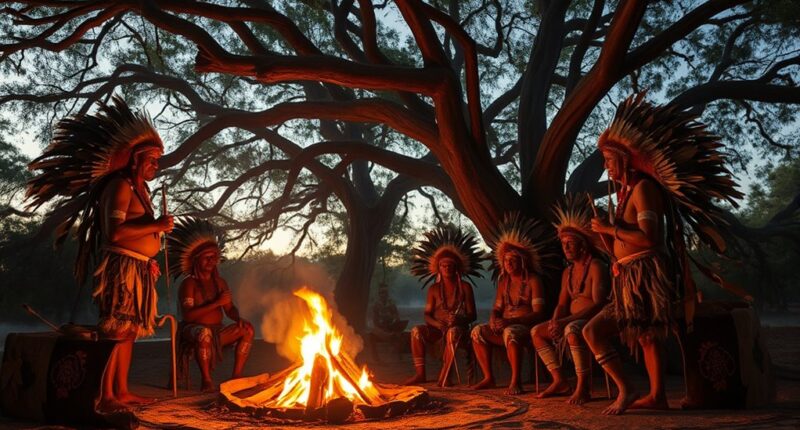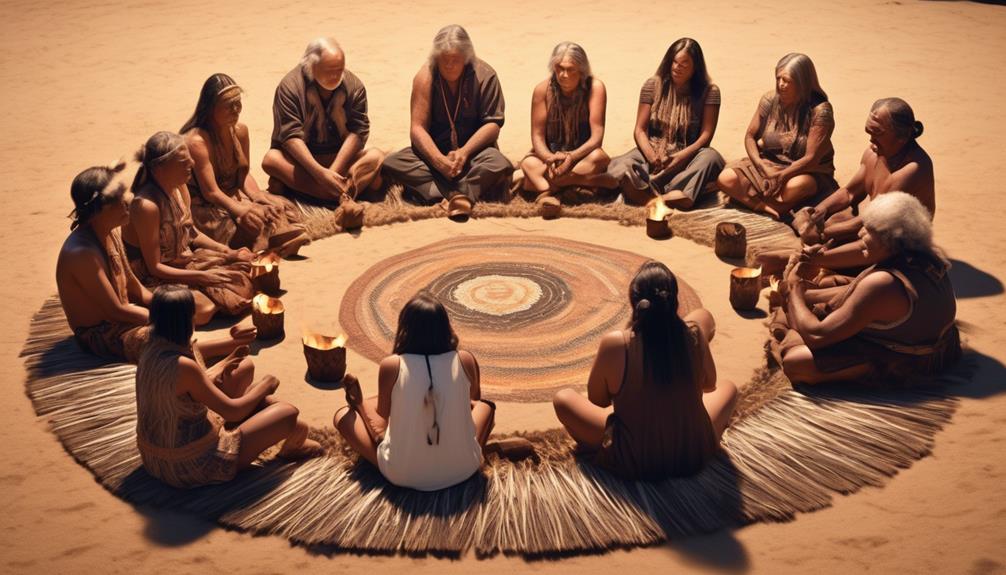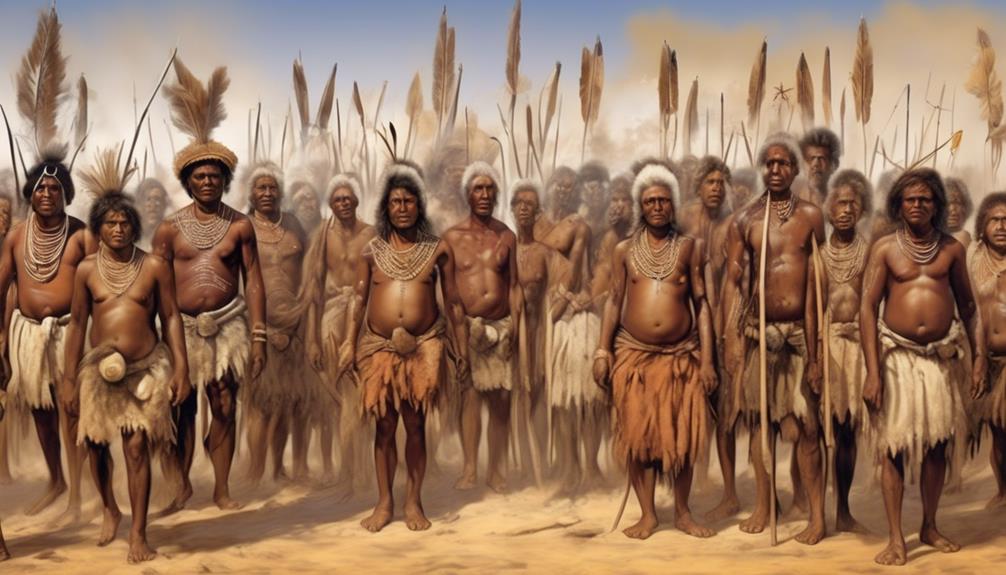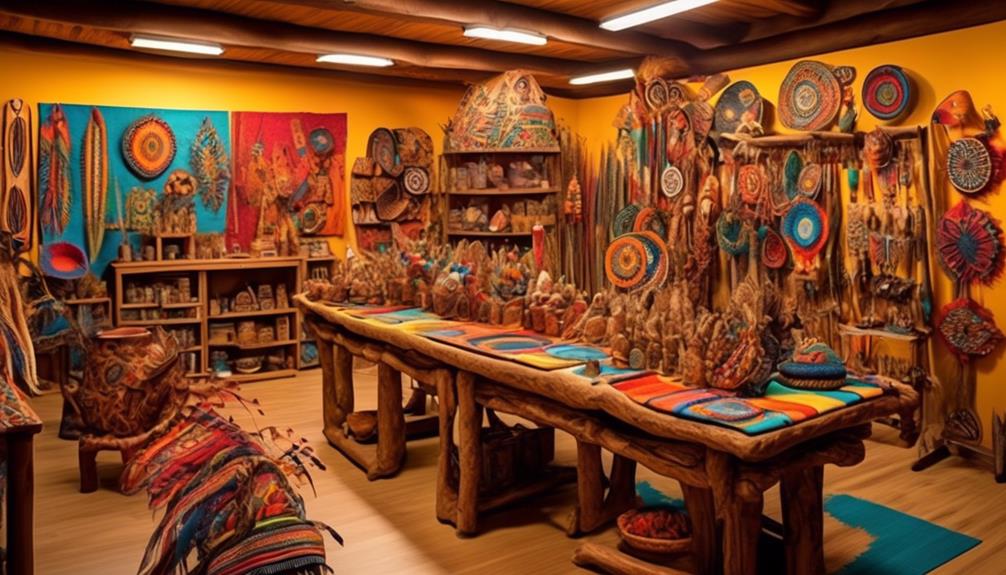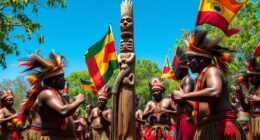In Aboriginal communities, seasons and ceremonies are tracked through land-based stories and environmental signs rather than Western calendars or clocks. You observe subtle cues like bird behaviors, plant blooms, and animal migrations, which are woven into cultural stories that act as living calendars. These stories guide you on when to harvest, celebrate, or prepare for weather changes, keeping traditions alive and understanding deeply connected to land’s natural rhythms. Keep exploring to uncover more about this fascinating cultural system.
Key Takeaways
- Indigenous communities use land-based environmental signs and stories to track seasonal changes and timing of ceremonies.
- Stories encode ecological knowledge, guiding resource gathering and ceremonial activities aligned with natural rhythms.
- Environmental cues like animal behaviors and plant flowering are woven into cultural narratives as a natural calendar.
- Dream symbolism and storytelling reinforce understanding of seasonal shifts and environmental indicators.
- Ceremonies serve as living practices that preserve and transmit ecological knowledge and cultural identity through land-connected timekeeping.

Have you ever wondered how Aboriginal communities track time and seasons? It’s not through calendars or clocks but through a deep connection to the land, and they pass this knowledge down through traditional storytelling. These stories aren’t just tales; they serve as living records of seasonal changes, weather patterns, and nature’s shifts. When you listen to these stories, you’re also learning about the timing of seasonal harvests, which are essential for survival and cultural practices. Aboriginal people observe subtle signs in the environment—birds’ behaviors, flowering plants, animal migrations—and weave these clues into their stories, creating a natural calendar that guides their activities. This way, every story becomes a marker for when to gather certain foods or prepare for upcoming weather changes. Scientific inquiry into dream symbolism reveals how these environmental signs are interpreted within their cultural context, reinforcing the depth of their ecological knowledge. In these communities, the cycle of seasonal harvests is intertwined with their storytelling traditions. For example, when specific plants bloom, elders tell stories that indicate it’s time to harvest certain roots or fruits. These stories act as a cultural timetable, ensuring everyone knows when to collect resources without the need for written dates. The seasonal harvests aren’t just about food; they’re also about maintaining harmony with nature, respecting the land, and passing on cultural wisdom. As the stories evolve, they incorporate new observations, keeping the calendar dynamic and adaptable to local conditions. This continuous storytelling ensures that each generation understands the land’s rhythms and the appropriate times for gathering, hunting, and ceremonial activities.
You might not realize it, but this approach to tracking time is incredibly sophisticated. It’s a living system that relies on keen observation, oral tradition, and an intimate bond with the environment. The stories encode knowledge about the seasons, weather, animal behaviors, and plant cycles, all of which inform daily life and community events. These stories are often recited during ceremonies or communal gatherings, reinforcing the calendar’s importance and helping younger members learn from elders. Through this method, the Aboriginal calendar isn’t just a way to mark time—it’s a holistic system that sustains cultural identity, ecological understanding, and social cohesion.
Frequently Asked Questions
How Do Aboriginal Calendars Vary Across Different Regions?
You’ll find that Aboriginal calendars vary across regions because ecological influences shape each community’s seasonal markers. In some areas, you notice timing based on animal migrations, plant cycles, or weather patterns unique to that environment. These regional variations help you understand that each community adapts their calendar to local ecological cues, ensuring they stay in harmony with nature’s rhythms. This diversity highlights the deep connection between culture and environment.
Are Aboriginal Calendar Practices Still Actively Observed Today?
Imagine holding onto a delicate, glowing ember that connects you to your ancestors. Today, many Aboriginal communities still actively observe their traditional ceremonies and seasonal markers, keeping their cultural flame alive. These practices serve as living threads, weaving history into daily life. By honoring seasonal markers and participating in traditional ceremonies, you preserve a sacred bond, ensuring that this rich cultural legacy continues to thrive for generations to come.
What Materials Are Used to Create Traditional Aboriginal Calendar Tools?
You might wonder what materials are used to create traditional Aboriginal calendar tools. These tools are crafted with traditional materials like wood, stone, shells, and bone, which reflect the resourcefulness of Aboriginal craftsmanship. You can see how these materials are carefully shaped and assembled, showcasing expert tool craftsmanship. Using natural, locally sourced materials, they create durable, meaningful tools that connect their knowledge of seasons and ceremonies to the land.
How Does the Aboriginal Calendar Influence Modern Indigenous Cultural Events?
Think of the Aboriginal calendar as a guiding star, shaping your cultural events through celestial navigation and seasonal storytelling. It influences modern Indigenous gatherings by aligning ceremonies with natural cycles, honoring ancestors, and celebrating seasonal changes. You see this in festivals that mark harvests or migrations, keeping tradition alive. This calendar acts as a bridge, connecting past wisdom to present practices, ensuring your cultural identity remains vibrant and rooted in the land.
Can Non-Indigenous People Learn and Participate in These Calendar Rituals?
You can absolutely learn about and participate in Aboriginal calendar rituals through cultural exchange, but it’s essential to approach this with respect and understanding. Non-Indigenous people should seek guidance from community members, honor traditions, and prioritize inclusive participation that respects cultural boundaries. By doing so, you foster genuine connections and support cultural preservation, creating meaningful and respectful engagement with these important indigenous practices.
Conclusion
As you walk through this vibrant tapestry of time, remember that the Aboriginal calendar isn’t just dates—it’s a living storybook of seasons, ceremonies, and deep connection to the land. It’s like a heartbeat echoing through generations, guiding you to honor traditions woven into every sunrise and sunset. Embrace this ancient rhythm, and let it remind you that time isn’t just marked by clocks—it’s a dance of nature’s everlasting song, waiting for you to listen.
Mary is a passionate writer who brings creativity and a fresh perspective to our team. Her words have the power to captivate and inspire, making her an essential contributor to our content. Mary’s commitment to storytelling and dedication to promoting Indigenous culture ensures that her work touches the hearts of our readers. We’re fortunate to have her as part of our team.
